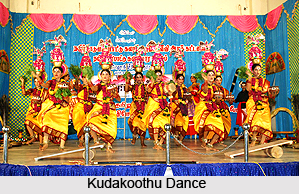 Kudakoothu is a folk dance famous in Tamil Nadu state of India. In this dance, the dancer has to balance a pot of water on the head while dancing. This traditional form of dance is also known as Karagam. The Sangam literature also knows Karagam by the name of Kudakoothu.
Kudakoothu is a folk dance famous in Tamil Nadu state of India. In this dance, the dancer has to balance a pot of water on the head while dancing. This traditional form of dance is also known as Karagam. The Sangam literature also knows Karagam by the name of Kudakoothu.
Villagers used to perform this dance in order to please the Goddess of Rain and the Goddess of River, known as Mari Amman and Gangai Amman respectively. The Goddess is also regarded as the protector from the dreaded small pox and cholera. This ritual is performed in the month of August.
It is the Karagam or Kudakoothu originated in Thanjavur. Kudakoothu dance is very popular all over Tamil Nadu, though its birth place is said to be Thanjavur.
Types of Kudakoothu Dance
Kudakoothu dance is of two types, one is Aatta Karagam and the other is Sakthi Karagam. Kudakoothu is usually performed with water filled vessel on the head, which is known as `Aatta Karagam. This dance form represents happiness and merriment. Aatta Karagam is performed only in the temples. This particular type is practiced to worship the Goddess.
On the other hand Sakthi Karagam is performed for the sake of enjoyment and entertainment. Kudakoothu is a very popular rural dance in India. Earlier, it was only accompanied by Naiyandi Melam but now it also includes songs. And the songs are accompanied by a number of musical instruments like `Thavil`, "Nadaswaram", "Muni", "Udukkai", "Pambai", etc.
Pots used in Kudakoothu Dance
The remarkable feature of Kudakoothu is the use of pots in it. However, the pots have changed over the years from mud pots to bronze ware or stainless steel in modern times. The pots are ornamented with cone of flower arrangements and topped by a parrot that is made of paper. The parrot swings when the dancer moves, thus making this dance form a kind of performing art in the true sense of the term.
Kudakoothu is carried out by one or two dancers, and both the male and female dancers can participate in it. Acrobatics similar to circus are included that involves difficult body movements like dancing on a rolling wooden block or moving up and down a ladder.
Apart from Tamil Nadu, this dance is also popular in Pondicherry, Andhra Pradesh (Garagalu) and Karnataka (Karaga). Most of the Kudakoothu dancers come from Thanjavur, Madurai, Tirunelveli, Pattukottai, Salem, Pudukkottai and Ramanathapuram.



















